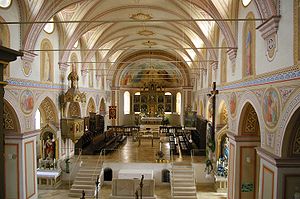
Ilmmünster Abbey
Encyclopedia

Ilmmünster
Ilmmünster is a municipality in the district of Pfaffenhofen in Bavaria in Germany....
in Bavaria
Bavaria
Bavaria, formally the Free State of Bavaria is a state of Germany, located in the southeast of Germany. With an area of , it is the largest state by area, forming almost 20% of the total land area of Germany...
in Germany
Germany
Germany , officially the Federal Republic of Germany , is a federal parliamentary republic in Europe. The country consists of 16 states while the capital and largest city is Berlin. Germany covers an area of 357,021 km2 and has a largely temperate seasonal climate...
.
The original site was a Benedictine monastery, founded in about 762 by the brothers Adalbert and Otker, traditionally supposed to be members of the Huosi, an ancient Bavarian noble family. The monastery was dedicated to Saints Arsatius
Arsatius
Saint Arsatius or Arsacius is a saint of whose life virtually nothing is known. He is said to have been a bishop of Milan, who lived either around 400 or in the 6th century, and possibly a martyr, but there is no evidence...
, whose relics were here, and Quirinus, whose relics were at Tegernsee Abbey
Tegernsee Abbey
Tegernsee Abbey or the Imperial Abbey of Tegernsee is a former Benedictine monastery in the town and district of Tegernsee in Bavaria. Both the abbey and the town that grew up around are named after the Tegernsee, the lake on the shores of which they are located...
, founded by the same brothers, to which Ilmmünster was affiliated.
A collegiate foundation was also set up here in 1060. In 1493 the monastery was transferred to the Frauenstift in Munich
Munich
Munich The city's motto is "" . Before 2006, it was "Weltstadt mit Herz" . Its native name, , is derived from the Old High German Munichen, meaning "by the monks' place". The city's name derives from the monks of the Benedictine order who founded the city; hence the monk depicted on the city's coat...
, leaving the site for the Kollegiatstift. The property and assets were sold off in 1802 during secularisation, but the impressive church remains.

